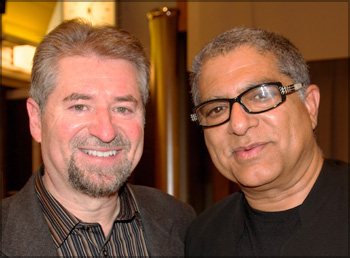by Alan Briskin | Collective Wisdom, Consciousness, Health, Leadership, Poetry, Spirituality, Wellness
A poem based on phrases and fragments of a speech* given by Deepak Chopra:
My grandchildren are here today
the most important part for me.
Here is my question:
What if consciousness
was not
a byproduct of our brain?
What if instead
it is the ground of Being,
the basement of the Universe
in geometric space-time
where all co-exists
as possibilities.
The great Rishi wisdom teachings
tell us consciousness
cannot be imagined
but makes the imagination possible.
Can you imagine?
From the basement of space-time,
everything is born from a quantum vacuum,
Beauty, Truth, Love, Joy, Compassion,
and also our Diabolical Self.
There is only the collective mind
that shows up as the individual mind.
The sage plunges into it,
expresses it, becomes one with it.
Healing is nothing more than
the memory of wholeness
Nature can say that the
human species
was just an experiment
that didn’t work out
Or Not!
The frantic search for security
only reinforces the insecurity.
Surrender to the mystery
of the divine,
which is constantly on the move.
My grandchildren are
here today,
the most important part.

* Deepak Chopra’s speech, on which this poem was based, was given on the day he received the Goi Peace Award** in Tokyo, Japan, November 8th, 2010.
I was there as a moderator the following day for a panel discussion with Deepak and thought leaders from Japan on the subject of death and dying, and wrote the poem from fragments of his speech and the group conversation.
The mission of the Goi Peace Foundation, which sponsored both events, is to bring people together in wisdom, united in their hearts toward the common goal of peace on Earth. By encouraging public awareness and building cooperation among individuals and organizations in all fields, they aim to build an international peace network and stimulate the global trend toward a culture of peace.
by Alan Briskin | Collaboration, Collective Folly, Collective Wisdom, Community, Conscious Capitalism, Health, Leadership

A serial journal of cogent reflections and irreverent insights on the social effects of capitalism and the roots of partisan politics. Pairing prose with HDR photography and “flash points” drawn from current and historical perspectives, the author seeks to recover lost wisdom and courageous action beyond the shouting and noise of today’s headlines.
Chapter Fifteen
Moving from Factions to the Whole: Paying Attention in New Ways
Part III: Social Perspectives>
Time Range: 1811, Current Times
 FLASH POINT
FLASH POINT
“If we move in mass, be it ever so circuitously, we shall attain our object; but if we break into squads, everyone pursuing the path he thinks most direct, we become easy conquest to those who can now barely hold us in check.”
— Thomas Jefferson, letter to William Duane, 1811
 Social Perspective: How Inequality Gets Under Our Skin
Social Perspective: How Inequality Gets Under Our Skin
What societal pattern might connect a heightened sense of mistrust, poor health, violence, diminished life expectancy, and low job status? If you guessed social and economic inequality, then we are beginning to think collectively together. But why? Why should this be the case? We would need to explore the multiple interlocking factors that determine and influence the frequency and distribution of this kind of pattern. We would need epidemiologists willing to use their training to identify the root causes of illness and other health-related events in social and economic circumstances, unrelated to any particular economic theory or ideology.
Remarkably, this is exactly what epidemiologists Richard Wilkinson and Kate Pickett set out to do in their book The Spirit Level: Why Greater Equality Makes Societies Stronger. With mind-numbing charts, diagrams, and statistical comparisons, these two professors documented why, by virtually every measure of well-being, the distribution of wealth far outweighs the importance of overall wealth in a community, region, or nation. Boiled down to its core, the results of these studies demonstrate how social and economic factions fracture the whole and make it worse off for everyone.
How so?
Social
and economic inequality creates exaggerated differences in social
standing, and social standing — our place in groups — has a dramatic
influence on our health, intelligence, well-being, and positive images
of the future. Here are three dramatic examples from animal and human
studies drawn from Wilkinson and Pickett’s work:

HDR (High Dynamic Range) Photography by Alan Briskin: multiple shots at different exposures are combined into one image in order to show “more of what’s there”.
- At Wake Forest School of Medicine in North Carolina, 20 macaque monkeys were initially housed in individual cages and then placed in groups of 4. Observers noted social hierarchies that developed, with special attention to the evolution of dominant and subordinate characteristics. They performed scans of the monkeys’ brains before and after the monkeys entered their social groups. Next, they allowed the monkeys to administer cocaine to themselves by pressing a lever. The results were unmistakable. The dominant monkeys, who showed evidence of increased dopamine activity in their brains after becoming dominant, took far less cocaine than the subordinate group. A plausible hypothesis was that the subordinate monkeys were in effect “medicating themselves against the impact of their low social status.” Conversely, the dominant monkeys were producing natural forms of stimulation and required fewer external boosts.
- In 2004, World Bank economists reported on a remarkable experiment. Three hundred twenty-one high-caste and 321 low-caste male children from rural areas of India were asked to solve various puzzles involving mazes. They did this without any knowledge of the other children’s caste, and the results were similar, with the lower-caste boys doing slightly better. Then the experiment was repeated, but this time with the announcement of each child’s name, village, and father’s name and caste. The results were dramatically reversed, with the lower-caste children’s performance dropping significantly. The epidemiologists noted the profound effect on performance and behavior in education based on “the way we feel we are seen and judged by others.”
- The Whitehall studies in England followed civil servants to assess the impact of job status on health issues. The initial study, which followed only men over a ten-year period, attempted to investigate the causes of heart disease and other chronic health problems by looking at job-related responsibilities. The initial hypothesis was that heart disease would be correlated with the stress of the highest-status jobs. The exact opposite was shown. Men at the lowest pay grades had death rates three times higher than their higher-grade administrators. A second study, Whitehall II, which included men and women, showed lower-status jobs related to higher rates not only of heart disease but also of some cancers, chronic lung disease, gastrointestinal disease, depression, suicide, sickness, work absence, and back pain. The study revealed that not only were the lower-status civil servants more likely to be obese, smoke, and have higher blood pressure, but these obvious health risks accounted for only one-third of the subjects’ increased risk of death. Poverty and unemployment were not factors, as these were all working people. The epidemiologists concluded that job stress and “people’s sense of control over their work seem to make the most difference.”
Wilkinson and Pickett highlighted the multiple ways in which heightened degrees of inequality lead to social disaster. The social disaster cannot be changed through techniques of mass psychology or medication or even education, which tends to replicate the existing social status of parents. What mitigates the effects of inequality is greater equality and greater signs of respect.
Greater economic equality might mean a goal of shrinking the economic disparity between the richest 20% and the poorest 20% of a nation to a ratio closer to 4:1, as it is in Japan and Scandinavian countries like Finland, Norway, Sweden, and Denmark, and less like 8:1 or 9:1, as it is in Singapore, the United States, and Portugal.
Respect might indicate behaviors that demonstrate an understanding that how we are seen by others is a major factor in physical and mental health, including anxiety levels, drug use, depression, the use of violence, and the experience of pain. Signs of respect are indicated by the presence of greetings, curiosity, honest feedback, and positive regard for others, and the absence of condescension, aloofness, and constant negativity. Dignity is a universal human need, and regard for the dignity of others is a foundational element of healthy social groups.
With this kind of social perspective on the nature of factions, we turn on its head the conventional ideal of who we should seek to emulate and why. In an article titled “The Pay Gap Is Vexing, but Don’t Blame the Rich: A Defense of the 1%,” Fortune magazine editor Nina Easton makes the more typical argument. She writes that while blaming the rich is convenient, it misses the point that this group of people demonstrates a level of talent, advanced degrees, and two-income, two-parent families that should be the envy of everyone.
To her credit, she points out that the nearly 1.4 million households in the United States that make up the 1% are quite a diverse lot, some with household incomes that, while substantial, are nothing near those of the billion-dollar-a-year hedge fund executives who have become the symbol of this faction. She concludes, however, on a point that is simultaneously misleading and dangerous: “It’s entertaining to wail about fat cats and the greedy rich. But if we’re serious about addressing widening inequality, we should figure out what the 1% is doing right — and apply some of those ideas to closing the gap.” (Nina Easton, Fortune, April 30, 2012.)
The remark is misleading because regardless of the diversity of this group, what makes them special is their household income, not their talents or degrees. We can’t all be in occupations that provide us with incomes offering more than the other 99% of the population. Further, based on the data provided by Wilkinson and Pickett, we would expect to see the group with the highest income demonstrate higher levels of education and lower rates of divorce. We would expect to see greater time and devotion to the success of their offspring. This is how class is replicated.
It is also to be expected that the higher-status group will be fascinated with why they are more successful than others, believing it must be their character, intelligence, or work ethic rather than the arbitrary nature of economic distribution or rights associated with privilege. The danger of this form of analysis is that it reduces the argument over economic distribution to one of simple human envy.
A dangerous social narrative is created that castigates anyone who dares to criticize economic arrangements and pivots the discussion back to the psychology of the individual. “Oh, you’re just upset because you don’t have a million dollars and a second home on an island.” This recourse back to the individual is supported by two deeply rooted assumptions: (1) there is no system better than the one we have, and (2) we cannot change human nature.
These may be comforting narratives for the status quo, but they ultimately fall into conflict with leadership theories on transformation. A transforming leader is one who willingly confronts uncomfortable issues with a belief that positive change can occur if people work together. Greed and self-interest may be obvious realities of human beings, but they need not be the basis for constructing our social world.
Factions destroy the ability to work consciously toward a union capable of holding disparate elements. In the end, it is not about the 99% against the 1%; it is about saving the dream of prosperity from collapsing into all-out warfare. Prosperity for all, in all the different ways that might be manifested, is a goal worth working toward. The majority of the 1% simply benefited from the arrangements granted them, and like any group of privileged human beings, they are not inclined to simply give them up. So be it. There are many among the 1.4 million wealthy households who would embrace a system that truly included them rather than putting them up on a pedestal or violently threatening to take them down.
Let there be no doubt that there is common cause for creating a world that works for all — on a relative if not absolute basis. So much creativity is yet to be released by working across sectors of business, government, and community initiatives. If there is to be sacrifice, it must be for everyone. The privileged should be the last group that seeks to be spared. Beyond sacrifice, however, there is much to be gained by truly unleashing the talents and passions of groups working on behalf of healing this planet that we inhabit together. This is the image of the future that we should hold dear.
This ability to hold an image of a positive future for all is deeply embedded in the collective psyche of this nation and this world. The Founders of the United States were for the most part privileged white men who negotiated a common cause at the expense of others, most specifically African slaves, whose freedom they denied. Yet among them were extraordinary figures like Franklin, Washington, Adams, Jefferson, and Madison. None of them were pure; all of them were tainted by the prejudices, animosities, and conflicts of their time. Yet, they shared an almost mystical understanding of union and common cause. This is the meaning left behind by Jefferson’s words to William Duane:
“If we move in mass, be it ever so circuitously, we shall attain our object …”
Never forget the true purpose of the journey. Do not be deluded by the long, winding, indirect path that must be followed. We can only reach the goal in mass.
“… but if we break into squads, everyone pursuing the path he thinks most direct, we become easy conquest to those who can now barely hold us in check.”
Be ever alert to individuals and factions promising a more direct route or advantages to only a portion of the collective. Stay united, even in your differences, or you will be subject to those who will return us to tyranny and unadulterated privilege.
Sitting off in a corner on a barstool is a disgruntled gentleman. He’s not one of the 1% or conservative guardians of privilege. No, it’s our old friend Karl Marx, and he’s not a bit happy.
NEXT WEEK: The Dark Prophet
Growth was virtually the only means to deal with shrinking profits, and it would engineer the need for excessive consumption of energy and other natural resources as dictated by the needs of the marketplace. Although Marx is not known for addressing ecological concerns, he predicted that the absence of any mitigating influence on capitalist laws of motion would result in undermining the “original sources of all wealth — the soil and the worker.”
by Alan Briskin | Business, Conscious Capitalism, Health, Politics

A serial journal of cogent reflections and irreverent insights on the social effects of capitalism and the roots of partisan politics. Pairing prose with HDR photography and “flash points” drawn from current and historical perspectives, the author seeks to recover lost wisdom and courageous action beyond the shouting and noise of today’s headlines.
Chapter Four, Part Two:
Out of Depression and War, a New Vision of Wealth Distribution
Time Range: 1929-1944, 2012
The economic bill of rights highlighted
a scar in the American psyche. Roosevelt’s time in office, which included a
failed coup d’état directed against him, deepened the resolve of factions
opposed to government intervention. From
this moment on, a widening split would cleave those who believed in federal
intervention from those who perceived arrogance in a government that addressed
questions of economic distribution.

HDR (High Dynamic Range) Photography by Alan Briskin: multiple shots at different exposures are combined into one image in order to show “more of what’s there”.

FLASH POINT
The Obama Economy–and Ours
Government didn’t build
that.
By Patrick J. Buchanan, July 24, 2012
“If you’ve
got a business, you didn’t build that. Somebody else made that happen.” Mitt
Romney fell on this Obama quote like an NFL lineman on an end zone fumble
during the Super Bowl. And understandably so.
For this
was no gaffe, said Romney, this is what Obama believes. This is straight out of
the catechism. Obama thinks that had not the government created the
preconditions, none of us could succeed. We all depend on government. None of
us can make it on our own.
Had Obama
been channeling Isaac Newton–”If I have seen further than others it is because
I am standing on the shoulders of giants”–or John Donne — “No man is an island,
entire of itself”–many would have nodded in agreement.
But what
Obama seemed to be saying–indeed, was saying–was that, without government, no
business can succeed.
Realizing
that statement rubs against a deeply ingrained American belief–that the people
built the nation–Obama and his acolytes are charging that Romney ripped his
words out of context.
Here is Obama’s full quote:
“If you were successful, somebody along the line
gave you some help. There was a great teacher somewhere in your life. Somebody
helped to create this unbelievable American system that we have that allowed
you to thrive. Somebody invested in roads and bridges. If you’ve got a
business, you didn’t build that. Somebody else made it happen.”

Conservatives, as opposed to liberals, proclaimed that people had a right to own what they owned and government should be on a very short leash. Government intervention should be held to the strictest criteria for determining what benefited the nation as a whole, especially in regard to infringing on private property and wealth accumulation.
The danger of deviating even a little from this principle, they warned, would unleash a swarm of another form of special interest groups, mostly those not very good at earning a living. This meant limiting what government should do and how much taxes it should collect.
If Roosevelt argued the moral and
political basis for ensuring freedom from want, conservatives argued the moral
and political basis for ensuring freedom of individual rights and protecting
those who succeeded on their own without government assistance. If one side
argued against the special interests of business and corporate influences, the
other side argued against the special interests of labor and minorities.
The interdependence of the whole was
visible to some and invisible to others. Both felt the success of the nation
was at stake. Both sides felt varying
degrees of contempt for the other, to the point where even the same words would
appear to have entirely different meanings.
 FLASH POINT
FLASH POINT
US Supreme Court: Closing Arguments Regarding Health Care Mandates
New York Times, March 30, 2012
“Solicitor General Donald B. Verrilli Jr. concluded his defense of the law
at the court this week with remarks aimed squarely at Justice Kennedy. Mr.
Verrilli said there was ‘a profound connection’ between health care and
liberty.
“‘There will be millions of people
with chronic conditions like diabetes and heart disease,’ he said, ‘and as a
result of the health care that they will get, they will be unshackled from the
disabilities that those diseases put on them and have the opportunity to enjoy
the blessings of liberty.’
“Paul D. Clement, representing 26
states challenging the law, had a comeback. ‘I would respectfully suggest,’ he
said, ‘that it’s a very funny conception of liberty that forces somebody to purchase
an insurance policy whether they want it or not.’”

To complicate matters further, discussion of the
proper role of government also pinched a nerve in the neck of the county’s
individualistic orientation. Going back to Henry David Thoreau, the view of
government was that it was the least capable of social institutions to do
anything right. Government was no more than a body of collective incompetents
compromised further by having to compromise with each other. Thoreau, a
naturalist, was not very fond of what he observed of human behavior,
particularly in regard to group behavior on the political stage.
So the mold was cast:
individualism, the right of private property, and state’s rights against those
who believed in groups, collective interdependence, and federal government
intervention. Hopefully the problems would just go away, because the lines were
drawn in such a fashion that no resolution was possible.

FLASH POINT
Health Care Reform and the Supreme Court
New York Times, June 29, 2012
The Supreme Court largely upheld President Obama’s health care law, the Affordable Care Act, in a mixed decision. The conservative chief justice, John G. Roberts, joined the
majority in affirming the central legislative accomplishment of Mr. Obama’s
term.
Chief Justice Roberts ruled that the key provision in
question, the so-called individual mandate requiring all Americans to buy
insurance or pay a fine, failed to pass constitutional muster under the
Commerce Clause, which was the heart of the administration’s arguments in favor
of it. But the chief justice declared that the fine amounted to a tax that the
government had the power to impose, and that the mandate could survive on that
basis.
The decision did
significantly restrict one major portion of the law: the expansion of Medicaid,
the government health-insurance program for low-income and sick people. The
ruling gives states some flexibility not to expand their Medicaid programs,
without paying the same financial penalties that the law called for.
The
debate over health care remains far from over, with Republicans vowing to carry
on their fight against the law, which they see as an unaffordable infringement
on the rights of individuals. The presumptive Republican presidential nominee,
Mitt Romney, has promised to undo it if elected.

Next Week: A shining City on a Hill, 1952-2956
In a dozen short years removed from FDR’s last State of the Union address,
the economic landscape had changed dramatically, or so it seemed. The brilliant
Robert L. Heilbroner, economist and
economic historian, could write that what distinguished the capitalism of the United
States from all others was its refutation of Marx’s assumption that government
could not be an impartial arbiter. American democracy, he proclaimed, tolerated and allowed
for an open discussion of class struggle without class warfare.










